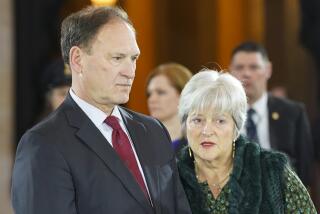More Than Just a Pen Pal
“The Forgotten Memoir of John Knox” is a beguiling book, part history, part “Upstairs, Downstairs” soap opera, all set in Washington, D.C., during one of the most momentous years of the last century. Its author, John Knox, was an ambitious young Harvard Law School graduate who snared a clerkship at the U.S. Supreme Court by becoming pen pals with several justices during college and law school and then inviting himself to Washington to meet with them. Along the way, he crossed paths with dozens of ambitious young men drawn to Washington by the New Deal, including Alger Hiss and future Michigan Gov. G. Mennen “Soapy” Williams.
By March 1935, Knox was on “such familiar terms” with his pen pal Justice Benjamin Cardozo that he telegraphed him to beg for a ticket to Oliver Wendell Holmes’ funeral. Cardozo obliged, and Knox took several days off from his studies at Harvard and met with Justice Willis Van Devanter for half an hour before the funeral. Eventually, he persuaded Van Devanter to pass his resume to Justice James McReynolds.
When McReynolds agreed to hire him as his clerk for the 1936-37 term, Knox became the only Harvard Law School student to reach the Supreme Court in this era without the influential sponsorship of Felix Frankfurter, who was a Harvard Law School professor before joining the court in 1939. According to the book’s introduction, “Knox had parlayed fascination with celebrity into a ... clerkship for a member of the Supreme Court of the United States, but he scarcely had any idea of what (or whom) he was in for.”
Though brilliant at flattery, Knox was only moderately competent as a lawyer, and he ended his career as an insurance adjustor. He tried several times to interest publishers in his memoirs but never managed to get them published during his lifetime. It fell to two professors, Dennis Hutchinson of the University of Chicago and David Garrow of Emory University Law School, to rescue the manuscript, which gives a portrait of a Washington that disappeared several decades ago.
The book’s depiction of McReynolds, who served on the court from 1914 to 1941, reminds us of how recently a virulent anti-Semitism resided in some of our most important government officials. McReynolds so detested Justices Cardozo and Louis D. Brandeis (who were both Jewish) that no official court photograph exists for 1924, because McReynolds refused to sit next to Brandeis as protocol required; during Cardozo’s swearing in, he ostentatiously continued to read a newspaper at the bench.
McReynolds was a Kentucky native “who viewed public education and the virtue of the common man as humbugs.” He came to Washington to be a trust buster for President Theodore Roosevelt. Woodrow Wilson appointed him attorney general, only to promote him to the U.S. Supreme Court because he was such a disruptive Cabinet member. His deep-seated racism (McReynolds once sparked a public outrage by declaring his determination to protect “the poorest darky ... as well as the man of wealth in a mansion”) was constantly on display in front of his clerk--even though most of the comforts this lifelong bachelor enjoyed flowed out of the “Driving Miss Daisy” relationship he had with his devoted black messenger, Harry Parker, and his black maid, Mary. Harry and Mary call the judge “Pussywillow” behind his back, and Harry is constantly warning Knox to steer clear of the justice’s female friends if he wants to avoid provoking his jealousy.
What gives the book its importance is the period it covers: Knox’s clerkship coincided with Franklin Roosevelt’s ill-fated attempt to “pack” the Supreme Court with additional justices after it had overturned so many of the laws which made up the New Deal.
Congress refused to go along with Roosevelt’s plan, but after the plan was announced, the court began to affirm many of Roosevelt’s most important pieces of legislation (including a minimum-wage law) by 5-4 margins. When the reactionary majority disappeared, after Justice Owen J. Roberts began to vote to affirm Roosevelt’s initiatives, Knox rightly notes that he was “witnessing the end of an era and the death of an entire way of thinking ... America was indeed at a turn of the road.”
The high drama of the court’s confrontation with the president and the backstairs intrigue in McReynolds’ elegant Washington apartment combine to produce an irresistible volume. And a photograph in the book gives it an interesting link to the present day. By 1952, Knox and McReynolds were long gone from the court, but Parker, McReynolds’ devoted messenger, was still there, working for Associate Justice Robert H. Jackson. That year, Parker posed for a photograph with Jackson’s new clerk, William Rehnquist. As chief justice of the Supreme Court, Rehnquist and his allies have written many opinions that have resurrected the same kind of federalism that McReynolds championed before 1937.
*
From ‘The Forgotten Memoir of John Knox’
Some days, after burning his morning mail, McReynolds would become unusually restless and then decide to go out for a walk. At such times he always carried his walking stick with him, which was made of strong wood and was rather heavy. Soon after the anonymous letters and postcards began arriving, however, Harry announced that the Justice should not go out alone for fear of his being assaulted in broad daylight.... “I’ll go alone--like I always have!” McReynolds would reply heatedly. “If anybody dares hit me, why, why, I’ll strike him with this walking stick!”
More to Read
Sign up for our Book Club newsletter
Get the latest news, events and more from the Los Angeles Times Book Club, and help us get L.A. reading and talking.
You may occasionally receive promotional content from the Los Angeles Times.







